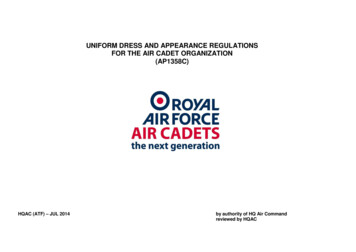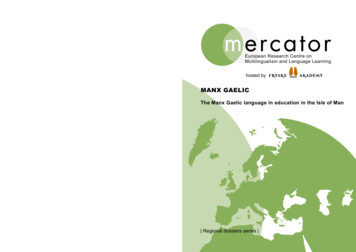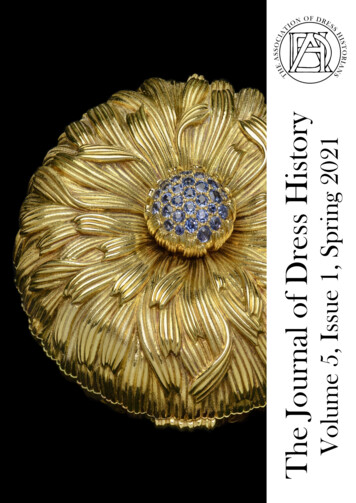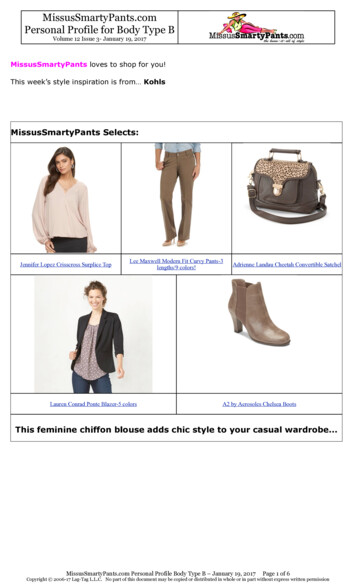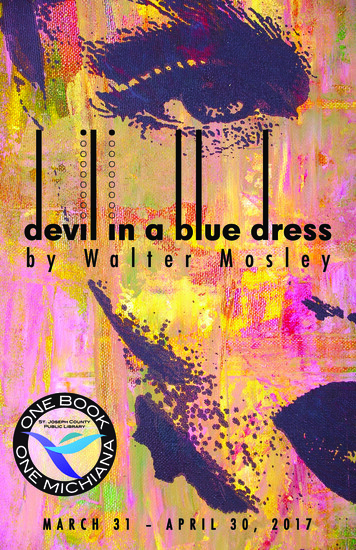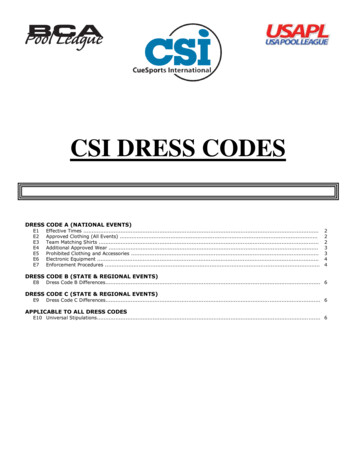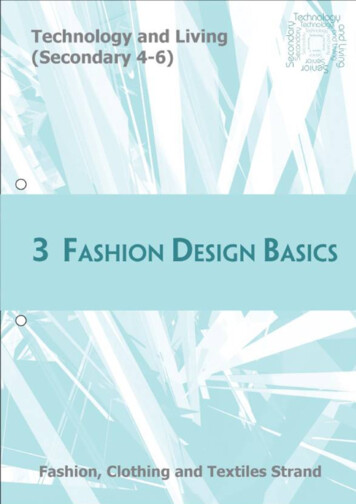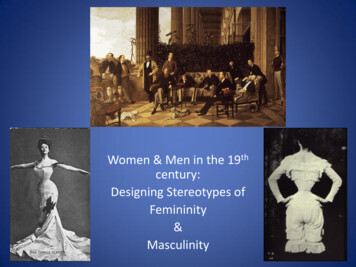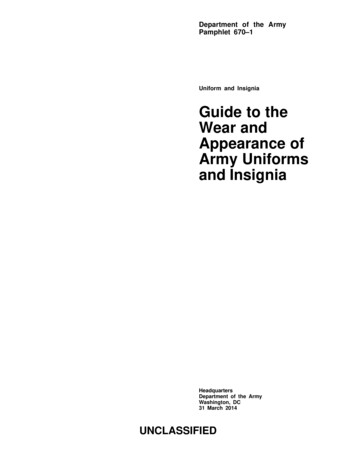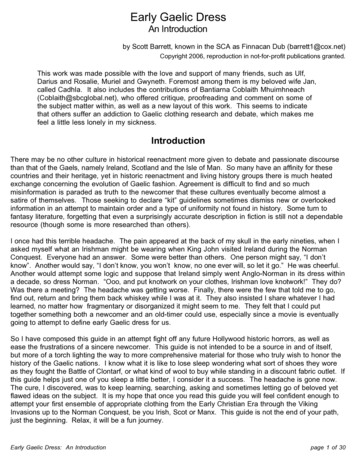
Transcription
Early Gaelic DressAn Introductionby Scott Barrett, known in the SCA as Finnacan Dub (barrett1@cox.net)Copyright 2006, reproduction in not-for-profit publications granted.This work was made possible with the love and support of many friends, such as Ulf,Darius and Rosalie, Muriel and Gwyneth. Foremost among them is my beloved wife Jan,called Cadhla. It also includes the contributions of Bantiarna Coblaith Mhuimhneach(Coblaith@sbcglobal.net), who offered critique, proofreading and comment on some ofthe subject matter within, as well as a new layout of this work. This seems to indicatethat others suffer an addiction to Gaelic clothing research and debate, which makes mefeel a little less lonely in my sickness.IntroductionThere may be no other culture in historical reenactment more given to debate and passionate discoursethan that of the Gaels, namely Ireland, Scotland and the Isle of Man. So many have an affinity for thesecountries and their heritage, yet in historic reenactment and living history groups there is much heatedexchange concerning the evolution of Gaelic fashion. Agreement is difficult to find and so muchmisinformation is paraded as truth to the newcomer that these cultures eventually become almost asatire of themselves. Those seeking to declare “kit” guidelines sometimes dismiss new or overlookedinformation in an attempt to maintain order and a type of uniformity not found in history. Some turn tofantasy literature, forgetting that even a surprisingly accurate description in fiction is still not a dependableresource (though some is more researched than others).I once had this terrible headache. The pain appeared at the back of my skull in the early nineties, when Iasked myself what an Irishman might be wearing when King John visited Ireland during the NormanConquest. Everyone had an answer. Some were better than others. One person might say, “I don’tknow”. Another would say, “I don’t know, you won’t know, no one ever will, so let it go.” He was cheerful.Another would attempt some logic and suppose that Ireland simply went Anglo-Norman in its dress withina decade, so dress Norman. “Ooo, and put knotwork on your clothes, Irishman love knotwork!” They do?Was there a meeting? The headache was getting worse. Finally, there were the few that told me to go,find out, return and bring them back whiskey while I was at it. They also insisted I share whatever I hadlearned, no matter how fragmentary or disorganized it might seem to me. They felt that I could puttogether something both a newcomer and an old-timer could use, especially since a movie is eventuallygoing to attempt to define early Gaelic dress for us.So I have composed this guide in an attempt fight off any future Hollywood historic horrors, as well asease the frustrations of a sincere newcomer. This guide is not intended to be a source in and of itself,but more of a torch lighting the way to more comprehensive material for those who truly wish to honor thehistory of the Gaelic nations. I know what it is like to lose sleep wondering what sort of shoes they woreas they fought the Battle of Clontarf, or what kind of wool to buy while standing in a discount fabric outlet. Ifthis guide helps just one of you sleep a little better, I consider it a success. The headache is gone now.The cure, I discovered, was to keep learning, searching, asking and sometimes letting go of beloved yetflawed ideas on the subject. It is my hope that once you read this guide you will feel confident enough toattempt your first ensemble of appropriate clothing from the Early Christian Era through the VikingInvasions up to the Norman Conquest, be you Irish, Scot or Manx. This guide is not the end of your path,just the beginning. Relax, it will be a fun journey.Early Gaelic Dress: An Introductionpage 1 of 30
A Few TermsThe GaelsBefore getting to the really juicy stuff, I need to establish some terminology. First, let me clarify what Gaeland Gaelic mean. The Gaels were those tribes and nations that spoke a language called Gaelic, alanguage that is part of the Goidelic group of early European languages. It was once a more singularlanguage than it is today, as each Gaelic country now has its own dialects.So when I refer to Gaels, I’m referring to the Irish, the western Scots and the Manx. I don’t use the termCelt or Celtic because these words don’t clearly identify these cultures. Goidelic tongues were just onelanguage group in a whole family of Celtic languages. It’s also important to remember that the early Irishand Scots did not call themselves “Celts”.The IrishThe Gaels were the early peoples of Ireland, called Eire, and quite possibly conquerers of the island inthe late Bronze Age or early Iron Age. Historians believe the island had a native culture that wasinterrupted by the arrival of these European people, yet debate rages as to precisely when this occurred,or how quickly the invaders changed the predominate culture. One thing that is certain is the suddenappearance of more European objects and jewelry in Ireland that correlate to later Bronze Age art andornament found on the continent. As the Iron Age gave way to the Dark Ages, the Irish had developed anoriginal framework of art, spiritual thought and social interaction. By the time the SCA begins thecountdown of the Medieval Era--i.e., 600 A.D.--the Gaels are the established inhabitants of all Ireland andhave been for centuries. Their language, the Old Irish Gaeilge, is probably the root tongue for the Manxand Scottish dialects.The ManxAs the Irish traded with and raided their neighbors, they established their culture on the Isle of Man in themiddle of the Irish Sea. Man had a native farming and fishing culture before Iron Age Gaelic influencesappear. Most Manx historians conclude that the native people were originally from Europe, via Britain. AsIrish missionaries settled in Man, the natives became more Gaelic. This culture was heavily influencedby Norse settlers, however; more so then any other in this guide. Manx Gaelic, called Y Gailck, borrowedsome from the Old Norse and is a language unlike any other, with both Goidelic and Brythonic roots.The ScotsScotland has long been considered a Gaelic nation, but its origins are a dangerous subject, leading toraised voices and angry dispute. Before the influence of Gaelic culture, Scotland was the native home of apeople called the Picts. The Picts were the reason the Emperor Hadrian built the wall (to defend RomanBritain from the Picts as well as control trade and commerce). What little remains of Pictish art shows apeople engaged in original religious and artistic expression. Ancient chronicles state that an Irishdynastic clan called the Dal Riada arrived in western Scotland in the 5th century and ruled a kingdomcalled Argyll, eventually uniting with the Picts under a king named Kenneth MacAlpin about 400 yearslater. However, new theories concerning the arrival of Gaels have appeared. These new theoriessuggest not only that Gaels were in western Scotland much earlier than assumed, but that they were notas dependent on Ireland and its customs. In fact, it may very well be that the Dal Riada were the oneswho introduced many fashions and social norms to Ireland, reflecting Roman, Pictish and even southernEuropean inspiration. Grave finds and archaeological discoveries appear to support these positions sofar. History learns something new every day.Early Gaelic Dress: An Introductionpage 2 of 30
The Isle of Iona, situated between Ireland and Scotland in the Irish Sea, became a bastion of insularChristianity, and the new religion spread throughout Scotland with all of its distinctive Gaelic trappings.Picts converted, fought with the Scots of Argyll, married them as well, and soon began to adopt elementsof their culture and language despite regaining control of much of Scotland in the last years of theirexistence. Within a generation of the first Norse settlements, the Picts were no longer a distinct andseparate people. Scotland was by then a predominately Gaelic country, though home to manyScandinavian folk. Scots Gaelic, or Gaidhlig, would result from a sprinkling of Norse and Pictish termsinto the original language of the Argyll Scots.Types of Research SourcesThis next set of terms is of use when approaching any subject, not just historical dress. Learn todistinguish your sources. Having a source is an excellent way to avoid unsubstantiated conjecture. Betterstill is being able to spot the different types of sources and knowing which carry more weight.A primary source is exactly what it sounds like. It’s a shoe, or a brooch, or any other extant item that canbe examined, measured and possibly replicated. A primary source may not solve every archaeologicalmystery. Certain items are enigmas. We aren’t sure how they were used or what their significance was.As our body of knowledge grows, the mystery item may reveal itself in the bigger picture. It could remain athing of conjecture for centuries, mute and never giving up its secrets. However, sometimes it’s a shoeafter all.A secondary source is less immediate, yet still can be of immense help in historical research. It isusually a direct recording or accounting of an item or event. Examples include paintings and sculptures,literature and poetics that describe the event or item, similar events or items in the same timeframe andarea, even excavation reports on finds lost or destroyed. Multiple secondary sources are generallyconsidered a substantial body of evidence in the academic community, if those sources withstandscrutiny.Tertiary sources are a distillation of information and commentary, like this guide. Fact and trivia books,encyclopedias, beginners’ guides--these things are all considered tertiary. They can be very useful butshould not be looked upon as authorities. They don’t qualify as good documentation. In fact, if you writedocumentation, that documentation becomes a tertiary source and should be considered an outline ofevidence, not the evidence itself.I’ll warn you right now: most of what is presented in this guide is based on secondary sources. We havenot found a 9th-century Scottish prince in near-perfect condition buried in the peat. It looks unlikely that wewill anytime soon. Textiles don’t survive burial well. Then again, a royal poet and his wife could be foundtomorrow, the embroidery still shining on their garments. Who knows?Period UsageFinally, a quick comment on that most abused of SCA terms, “period”. Technically, anything fallingbetween 600 and 1600 A.D. is within the SCA era. However, wearing an Elizabethan doublet with a Saxonspangenhelm is not accurate or appropriate. Both are “period”, but neither is appropriate to the other’stimeframe. I bring this up in hopes that “Celts” stop painting woad on their faces while carrying 16thcentury Scottish Claymores on their backs.Yeah, I know, but I can dream. . .Early Gaelic Dress: An Introductionpage 3 of 30
The SourcesYears ago I made the decision to try to emulate accurate Irish wear to the best of my ability, and thereby tohonor the history of Ireland, rather than my preconceived notions of what it should be, or what I wanted itto be. Once I made this decision, I found myself not knowing where to turn. I ran into a number offrustrated Scotsmen as well and empathized with their plight.The Internet was just starting to take off. I was able to track down a few resources within a year of finallygetting online. Still, pickings were slim. What little I could locate has proven invaluable--two works inparticular. These two books, along with museum pieces, art, archaeological reports, and poetics from thetimeframe, form the core of this guide. I will refer to other sources throughout this guide and include abibliography for your future endeavors, but these books are so heavily used that I wanted you to be familiarwith them from the beginning, so that you have an idea what is being referenced as you read this guide.They should be yours to read at your leisure, as they will lead to your own speculation, experiments, andconclusions (which archaeology may verify for you in the future). They will also provide you with a level ofinvestigation and detail I cannot offer you.Dress in Ireland: A History, by Mairead Dunlevy, The Collins Press, 1989; ISBN 1-898256-84-5This is the only book dealing with this subject still in print at the time of this writing. Though it doesn’tcover Scotland and Man as separate cultures, it does provide a large amount of detail for the garmentsand items worn by the Irish through many periods. It is more comprehensive and linear than McClintock’searlier work, covering differences between native dress and foreign fashion. It can be located onAmazon.com as well as through interlibrary loan.Old Irish and Highland Dress, with Notes on That of the Isle of Man, by H.F. McClintock, DundalganPress, 1943Well, the bad news is that this work has been out of print for quite some time. Even an interlibrary loanhas a hard time finding it. It may still haunt some old bookshelf in your area, but good luck finding it. Now,here is the good news. www.Scotpress.com has for sale on CD not only this entire book, but manyothers as well, most of which deal with Scottish and Irish history. So you may very well be able to get thesweat-drenched work of Old Man McClintock for yourself. It is worth every penny. McClintock is thepioneer in this field, charged with determining historic Irish dress for the Irish government in the ‘forties.Before him was P.W. Joyce, author of a text called A Social History of Ancient Ireland, which was basedon the Victorian work of Professor O’Curry, Manners and Customs of the Ancient Irish, published in 1873.O’Curry was a sound scholar but he proposed translations that simply didn’t pan out when investigated,especially concerning fashion, so McClintock started over. He gives the reader sculpture and shrines, artand literature, sacred texts and even Brehon Law to back his conclusions. Though some of whatMcClintock wrote is now a little dated, his writing remains the foremost resource for this topic.Neither of these works is definitive. Discoveries and more detailed understandings of daily life and dressare coming to light every day. However, these books form a strong foundation for any scholar orenthusiast to begin their dabblings and should be sought with haste.I have also turned to a few sources these authors used, primarily the Book of Kells and the Book ofDurrow, which date from between the 7th and 9th centuries. Scans from both can be found online. Theseartifacts of illuminated wonder have also had numerous books written about them, one of which is TheBook of Kells, by Peter Brown, Thames and Hudson, 1980 (ISBN 0-500-27192-5).I also explored the Tain bo Cuailnge, an Irish epic first penned in the 1100’s and translated by numerousauthors. My favorite translation of this work is The Tain: From the Irish Epic Tain bo Cuailnge, by ThomasKinsella, Oxford University Press, 1969 (ISBN 0-19-280373-5).Early Gaelic Dress: An Introductionpage 4 of 30
The GarmentsThe Léine (Tunic)The léine (lay-nah) is the Gaelic tunic, or shirt. The plural form is léinte (layn-tah). This garment, wornagainst the skin, is the primary wardrobe item. Though perhaps made of wool in the late Bronze Age, it isusually made of linen by the early Christian era, linen being abundant in the island nations. Although theléine was worn throughout the SCA timeframe, it changed drastically in shape as the centuries passed.We can picture and even fabricate the early léine, though we may never know its exact construction orfinish since linen almost never survives burial.McClintock, describing age-worn figures on the Cross of Muiredach in Monasterboice,says:The léine as it appears on the cross is a long smock-like garment, not unlikethe ‘galabeeah’ worn by the natives of Modern Egypt, rather narrow in the skirtand decorated round the lower border with a band of embroidery. (p.4)detail from thewest face of theCross ofMuiredachDunlevy gives her interpretationof the early léine as asleeveless, ankle-lengthgarment worn by both sexes(p.17). It should be noted thatby the 9th century (800 A.D.),léinte illustrated in the Book ofKells are long-sleeved andtapered to the wrist, notsleeveless. It may be that theléine, once a simpletwo possible variants of the léinerectangular or tube-wovenThe sleeveless is likely disappearing in 600 A.D.garment held onto the body bybrooches at the shoulders,became a more tailored and form-fitting garment by the beginning of the 6th century.It appears to have been slipped over the head, belted at the waist and worn ankle-length, thoughMcClintock notes that the Tain Bo Cuailnge (The Cattle Raid of Cooley, or just the Tain) sometimesdescribes it as “girt”, or drawn up to the knees, for more physical activities.The Book of Kells shows a variety ofnecklines used on the léine, includinground, oval, triangular and square.possible culpaitsEarly Gaelic Dress: An Introductionvarious necklines visible in the Book of KellsThe hood is likely the more common in the SCA timeframe.It also is sometimes described as having a culpait (culpage), which can mean either a collar or a hood. Dunlevystates, “It often had a culpait, or substantial collar, whichlater became a hood,” (p.17). A hooded léine was called aculpatach, or culpaideach (cul-pay-jeek). We don’t knowhow this “collar” or “hood” was constructed.page 5 of 30
Dunlevy indicates a possible hood on the Virgin’s léine in the Book of Kells (p. 21).If this is indeed a hood under her veil, than it may be that the hoods on early léintewere constructed as simple rectangles of fabric that draped down from the neckas one might imagine on a Greek Doric chiton. There is no indication that theculpait was a separate item like a cowl.This early léine was likely clasped at the shoulders. It seems reasonable toassume that the léine altered in form as tailoring advanced in northern Europe.Though no intact léine has been found, the probability that it was made tocomfortably fit the wearer seems evident. Gores in the skirts and gussets underthe arms may not have appeared until well into the 8th century, yet sleeves andnecklines in the Book of Kells indicate a quality garment that was neither skin-tightnor loose.detail from the Bookof Kells, folio 7v:the Virgin’s headIt wouldn’t be proper to think of the léine as an “under-tunic”. That implies agarment always covered by another. Think of the léine more as a tunic. It was often worn alone. Anythingworn over it was considered outerwear.FabricIt can be a little confusing trying to decide what fabrics to use when making a léine. The Tain, mentionedabove, describes a number of léinte as silk or “glossy” in appearance. It makes reference to a linen léineonce (McClintock p.3). Both Dunlevy and McClintock concede that the léine was almost always a linengarment, and that the Tain is given to heroic excess in its descriptions. However, it should be noted thatthe Irish had silks available to them, especially after the appearance of Norse settlements, and that it waslikely a status symbol to own as much as possible. Markets in Limerick in the 10th century had silks andsilk satins of many colors available, as well as many other rich fabrics. The vast majority of this fabricwould have been used for trim and decoration, not entire garments (Dunlevy p.22).Today the term “linen” refers to fabrics made from flax, but in the Middle Ages linen may also have beenmade of ramie, hemp or nettle fibers. A léine made of ramie may be even more authentic than one madeof flax linen, as flax was not as abundant as nettles in Ireland, England, Man or Scotland, and nettleswould have produced a fabric almost indistinguishable from ramie. (Ramie is actually made with aChinese nettle and is one of the oldest textile plants known.) Hemp has a long and well-dispersedhistory as a textile plant for making linens; the oldest woven fabric found to date is made from hempenthread. After awhile, all of these fibers are nearly identical, even to experts. They make fine linens andshould be seriously considered when fabric shopping.Though linen may seem an extravagance these days, many medium-weight linens are available on themarket, often for less than cotton/poly blends. One of the most popular sources for 100% flax linenamong reenactors is this website: www.fabrics-store.com. I highly recommend them and I am not alonein my enthusiasm. Before you head to the local discount fabric outlet, consider this: most “linen” in suchlocations is not 100% linen (which you will want for any summer outdoor event, trust me!), and the linenthat is pure is usually astonishingly expensive. So you’ll find yourself settling for muslin that will wear outin a few years or a polyester blend that won’t breathe and is likely to melt when accidentally exposed to acampfire. Cotton can be more expensive. You’ll love how linen softens and you’ll save money beingaccurate and comfortable. I’m not talking handkerchief linen here, but the simple twill weave linen you willsee at the fabrics-store website.Early Gaelic Dress: An Introductionpage 6 of 30
ConstructionDespite the lack of patterns for the léine, it is not too difficult to piece together how a léine may have beenmade, especially if you look at evidence for tunic construction from surrounding countries and the traitsthose tunics shared. The garment is basically a tunic seamed at the sides with hems and a finishedneck opening. It may have been joined at the shoulders with a seam as well. It could be sleeveless orhave sleeves attached at the shoulder. It may have once had a center seam running down its front andback to allow for more volume in the body. It may also have had center or side splits for movement,though descriptions of girting-up the léine seem to undermine this idea, in my opinion. As the Viking Agebegan, this possible center seam would have likely been replaced with gores in the sides of the skirting,with center gores appearing soon after. Gussets may have appeared at the armpits for better fit. Inlength, it is described as varying from thigh to ankle. A longer léine seems to be a wealthier choice andmay have indicated status.As an author’s suggestion: Consider putting in the accurate seams for the léine. It fits more comfortablyand looks more accurate. Avoid the “T-tunic” cut; attach sleeves separately, and use gores if appropriate.Even if you have 60-inch-wide material, adding the seams makes a huge difference, visually. Finally,matching the construction thread color with the garment color is not always a given in this timeframe, socreativity with contrasting hues might be an option.ColorA common term used to describe léinte is gel, which means “bright”. This could indicate a number ofthings. Dunlevy notes that léinte are white or gel, which may mean “unbleached” or “natural in hue” (p.17).McClintock noted a number of interestingdescriptions of the léine in the Tain, such as“white”, “yellow”, “brown-red” (madder?) and“striped” (p.3). General consensus seems to bethat white, natural and yellow were probably themost common colors for a léine simply becausethese hues are easiest to achieve in linen.Though it is true that linen does not take dye asdeeply as other fabrics, it will certainly hold a widevariety of colors, and a well-made léine wouldhave been dyed multiple times as color faded withwashing and exposure to sunlight. The Book ofKells illustrates how varied the léine could be;angels and saints alike wear blue, green, purple,red and golden léinte. The Virgin Mary wears apink léine (the color easily achieved with perioddyes).With modern dyes we are able to achieve morebrilliant shades in linen than would have beenseen in the Dark Ages. Choose more muted andsubtle colors. Better yet, look into period dyes andcolor your linen at home. That is one of the bestand simplest ways to get the color you want.Early Gaelic Dress: An Introductiondetail from theBook of Kells,folio 183rdetail fromBook of Kells,folio 29rdetail from theBook of Kells,folio 7v:Virgin and Childpage 7 of 30
DecorationSculptures, illustrations and literature all indicate a consistent addition to the léine: trim. Bands of trimcan be seen on most every single léine in the Book of Kells, at the hem, the cuffs and the neckline.Dunlevy mentions that as the léine became more fitted, so too it became more ornate (p.21) . As notedearlier, McClintock mentioned bands of embroidery while describing the Cross of Muiredach. That is notthe only sculpture McClintock studied. In fact, the majority of those he examined, like the Cross of theScriptures at Clonmacnois and the Shrine of St. Moedoc in the National Museum at Dublin, have visibledecoration on the garments.detail from the Book ofKells, folio 114r:soldier’s hemdetail from theBook of Kells,folio 7v:Angel’s cuffsdetails from theBook of Kells,folios 293r and183r: necklinesdetail from theeast face of theCross ofMuiredach: Cain’sand Abel’s skirtsHe also notes that the Tain seems to focus more on decoration than any otherfeature, the most common being embroidery of some sort that is gold, red-goldor merely red (p.3). This could have referred to a couple of techniques knownto have been used in the early medieval period. One possibility is that goldthread, which was gold flat wire wrapped around a linen or silk thread, wascouched down to the fabric using red thread. The other technique would be redtablet woven bands of silk or wool with gold brocade. These two techniquesappear to be the most common ways of displaying metallic threads.detail fromShrine of St.Moedoc: man’sskirtscouchingThe Leabhar na h-Uidhre (the Book of the Dun Cow, about 1100 A.D.) mentions the High King ConaireMor in a poem. In this piece he is wearing a léine with silken trim around his neck so filled with metallicthreads it reflects his face like a mirror. The garment also sports embroidery from his chest to his knees!Granted, the Ulaid or Ulster Cycle stories and poems (which include the Tain) contain many such vividdescriptions that are likely poetic liberties taken with epic figures engaged in epic deeds. But it doesindicate how important such decoration and display was to the early Irish, so decorating the léine seemsa foregone conclusion.How should you decorate your léine? Well, lacking extant garments, most historians, MClintock andDunlevy among them, look to the common textile arts of Ireland’s neighbors at the time. The mostcommon form of decoration is presumed to have been embroidery. This would include numerousstitches found in the region (such as running, stem, whip, split, and satin stitches) coupled withtechniques like appliqué and the previously-mentioned couching.running stitchstem stitchsplit stitchsatin stitchstitch diagrams courtesy of STITCH with the Embroiderers’ GuildEarly Gaelic Dress: An Introductionpage 8 of 30
Bands of embroidery might have been done directly on the garment, or done on strips of linen, wool, orsilk and applied later.Another option is tablet weaving (also called “card weaving”). This technique was widely used all overnorthern Europe and is common in the SCA. You can make bands of highly complex trim in numerousand varied patterns. A combination of tablet-woven trim, embroidery, and appliqué may have been usedon a single garment, especially among the wealthy.As to what motífs to use: most refer to extant manuscripts and metalwork for inspiration. Bands of color,key patterns, Christian-era spirals and Norse-influenced knotted beasts may be appropriate, dependingon your chosen timeframe. Some may argue that no interlace, or “knotwork”, was used on Gaelic dress.This brings to light a distinct problem in certain SCA circles. Avoid any historic discussion where theterms “always” and ”never” are used. That kind of absolute position is not proper in academic circles.Here’s an example of why:The argument against interlace is fairly strong, as supposedly no illustrations or sculptures show it beingused with any regularity. Yet, a closer examination of the topic pokes holes in the position of thealways/never types. Interlace is visible at the neckline in the image of the Virgin in the Book of Kells.It can also be found on the cloak of the Man in the Book ofDurrow, which dates from the 7th century. Loegaire Buadach,a member of the Ulster forces in the Tain, is described aswearing a yellow léine with interlace. (This reference has beenused to actually try and show modern-style lace being used bythe early Irish. If it was, no other mention of this complex craftdetail fromhas ever been found in the literature of the period, nor has anythe Book ofdetail from the Book of physical evidence appeared showing actual lace being madeDurrow,folioKells, folio 7v: theduring the Early Medieval timeframe in Ireland. The word is21v: theVirgin’s neckline“interlace” when translated and is used in a descriptiveMan’s bratfashion.)So, if you want interlace, I see no reason to completely avoid it. However, it would appear to have beenused sparingly. It also would have been less complex before the Viking age, when Norse settlersadopted the native interlace and brought it to new heights with their own contributions.I would encourage more distinctly Irish motífs such as the Christian-era spirals (not Bronze Age La Ténespirals) and the key patterns so prevalent in the sacred manuscripts and sculptures of the age. Theseare beautiful, very Gaelic, and far too rare in the author’s opinion.Christian-era spiralsEarly Gaelic Dress: An Introductionkey patternspage 9 of 30
The simplest form of decoration is not only the most expedient but also very striking and attractive. As Imentioned earlier, the Book of Kells has simple bands at hems, necklines and cuffs, some of which werevery likely strips of colored silk used as we use bias tape. This, in and of itself, is a magnificent finishingtouch to richer garments, an
by Norse settlers, however; more so then any other in this guide. Manx Gaelic, called Y Gailck, borrowed some from the Old Norse and is a language unlike any other, with both Goidelic and Brythonic roots. The Scots Scotland has long been considered a Gaelic nation, but its origins are a dange
